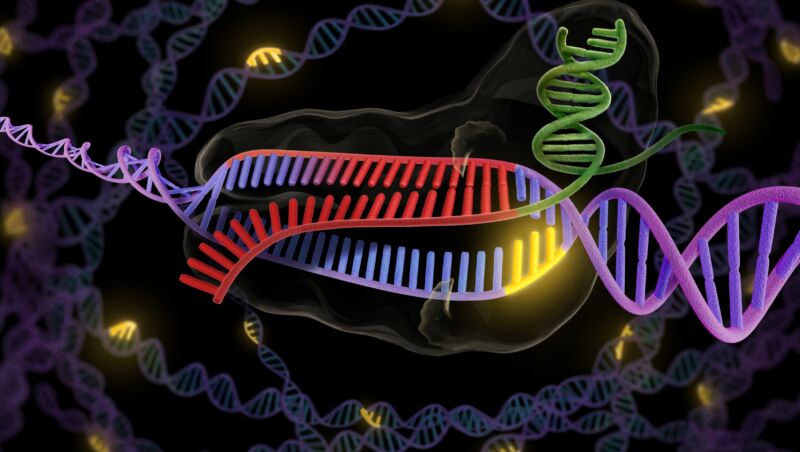First Clinical Trial Of Gene Editing To Help Target Cancer

The ability to edit genes has raised the prospect of treating genetic conditions and arming the body to better handle infectious diseases and cancers. But for that potential to be realized, we need to deal with a variety of safety issues and work out the ethics of when the technology is appropriate to use.
Today, scientists are releasing the results of a clinical trial designed to test the safety of gene editing as a way of fighting cancer. The results are promising, in that a version of the CRISPR gene-editing system that’s already a few years out of date appears to be safe when used to direct immune cells to attack cancer. But the cancers that it was meant to treat simply evolved ways of slipping past immune surveillance.
Editing genes to fight cancer
While there have been a number of gene-editing systems developed, CRISPR/CAS9 is currently the most flexible and efficient. It creates cuts in specific DNA sequences, directed to the sequence by a short piece of RNA. The normal cellular process of repairing these cuts often results in small deletions, which can knock out any genes affected. Alternately, if a replacement sequence is made available, the repair can incorporate the replacement, thus altering the targeted sequence. Either of these, however, can sometimes cause problems by cutting at related sequences or when the repair process accidentally creates large rearrangements.
For the clinical trial, this gene-editing system has been combined with recently developed immune therapies that target cancer. There is a class of immune T cells that kill cells recognized as foreign, either because they come from a different person (such as after an organ transplant) or because they are infected with a bacteria or virus. These cells can also recognize and attack cancer but often don’t, in part because cancer cells are so similar to healthy ones. People have engineered versions of the T cells’ recognition system that specifically target cancer cell and placed these back into patients, helping the immune system attack the cancer, sometimes with spectacular results.
As part of the clinical trial, gene editing was used to improve the efficiency of the cancer-targeting T cells. This was done in two different ways.
Of mice and TCR
The first was to target a gene that normally functions to tone down the immune system (called PDCD1). There has been evidence generated in mice that using antibodies that block the protein made from this gene will increase the immune system’s attack on cancers. For this work, the researchers targeted the CRISPR system to delete part of the gene itself, inactivating it. This poses a potential risk, as a failure to tone down the immune response can lead to problematic conditions such as autoimmune diseases.
The other way gene editing was used was to knock out the T cell’s normal system for recognizing foreign cells, called the T cell receptor (TCR). The TCR is composed of two related proteins that form a binary receptor complex. Engineered versions of this protein are the ones used to get cells to recognize and kill cancer. Normally, these engineered versions of the TCR are simply inserted into an immune cell, where both they and the cell’s normal TCR genes are also active. The result is four different TCR parts active at the same time, resulting in a variety of hybrid TCRs. At best, these are ineffective and will reduce the total amount of active TCR in a cell. At worst, they’ll cause the T cell to attack healthy cells.
For the trial, the researchers generated CRISPR constructs that targeted the cell’s normal TCR genes. When successfully deleted, this would ensure that the only TCR on the cell’s surface would recognize cancer cells.
Into the clinic
Putting these pieces together, the researchers decided to work with patients who had cancers recognized by a known version of the TCR genes. That meant myeloma, melanoma, and sarcoma patients who had failed other therapies and who had progressed far enough that potentially life-threatening risks weren’t a problem. The researchers started with a total of six patients, but three of them ended up failing to meet the criteria for the trial by the time everything else was ready.
That “everything else” involved obtaining T cells from the patients themselves and then doing gene editing on them to delete the two TCR genes and the immune regulatory gene. While the rates of successful editing were high, the procedure is nowhere near 100 percent effective, and rates of editing varied from nearly half down to 15 percent, depending on the gene. That means most of the T cells placed back into the patient would still have some intact genes. While the minority would be expected to have all three genes edited, the populations that respond best tend to live longer in the body.
Separately, the researchers inserted the genes for a T cell receptor that’s known to recognize these cancer types. With everything in place, they tested the cells for any problematic effects of all this engineering.
Sequencing of the DNA from engineered cells showed that there were some off-target edits, but the rates varied among the genes. This suggests there’s some work left to do in terms of designing the gene-editing constructs. There were also some large chromosomal rearrangements in response to the editing. The most common was a single deletion that took out both T cell receptors, which was fine for the purposes of this work. Other large rearrangements were present, but they tended to drop out of the population of engineered cells over time, possibly due to detrimental effects on their growth.
With that level of off-target effects considered an acceptable risk, the researchers then infused the engineered cells into three of the patients.
About what you’d expect
It’s important to emphasize that the patients chosen for initial safety testing are very far along in disease progression, making it difficult for anything to reverse their progression. That’s integral to the risk calculation of being involved in testing of what may be a first-of-its-kind therapy.
And in terms of safety, things seem quite promising. There were no serious adverse affects of the T cell infusions, no sign of a problematic immune response, and the cells persisted in the patients up to nine months after the transfusions, indicating they were tolerated well. Testing of these cells suggested that many of them had been converted into memory cells, which are able to respond quickly following new stimulation.
The response to the tumor, however, was limited. Two patients appeared to stabilize, while the third showed a response in some tissues but not in others. Ultimately, however, the disease began to progress again, and one of the patients has since died.
In examining the cancer cells from these patients, the researchers found something that you might expect: the protein recognized by the TCR used in these experiments had seen its levels reduced. This allowed the cancer to escape detection by the immune system—especially an immune system that had been reprogrammed to recognize this protein. It’s a standard evolutionary response to this sort of pressure and has been seen in cancers in other contexts.
Still, from the perspective of the goal of this trial—basic safety—the trial was a success and will likely lead to further safety tests on a larger population. These will likely be able to leverage advances in gene editing that have occurred since the first trial was designed and involve enough patients that we’re likely to be able to detect a broader spectrum of responses to the therapy. It’s possible that larger trials could identify a sub-population of patients where this therapy works better or provide hints of how to combine it with additional therapies that improve its effectiveness.
Science, 2020. DOI: 10.1126/science.aba9844 (About DOIs).
READ MORE HERE



